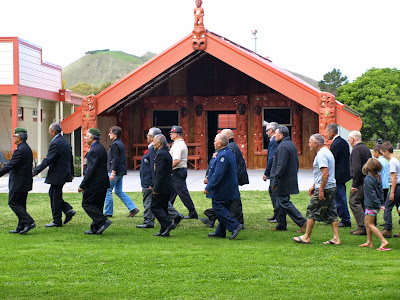This whistle is used by the shepherd to communicate with his
shepherding dogs. Each dog has its own distinct set of whistles that only he
recognizes. By maneuvering the whistle in his mouth, the shepherd can tell each
dog, individually, to turn right or turn left. Those distinct sounds can tell
each dog whether to go forward or backwards; whether to stop, start, or go up
hill. This communication between a man and his dogs takes time to develop and
it requires great patience in the process. The human must learn to maneuver his
mouth and that small piece of tin so that a myriad of sounds is produced and
the dog must be taught to focus so well that he can selectively hear only those
whistles meant for him personally. The end result is that one man or shepherd,
can with the help of his dogs, have complete command over a great number of
sheep.
It has been
fascinating to observe how one shepherd and three or four dogs are able to
direct whole herds of sheep. We observed, spell-bound as this scene unfolded in
front of us one day as we were caught in a “sheep jam” on our way to Wairoa.
There were about two hundred head of sheep blocking the road, and as we
watched, we could also hear the shepherd, whistling for his dogs. Those
well-trained dogs reacted to their instructions and that mass of sheep was
turned as if of one mind and the whole lot of them was herded into a roadside
paddock in a matter of moments. It was fascinating and as we passed, we spoke
to the shepherd, who showed us that he keeps that whistle tucked into the side
of his cheek for handy access at all times!
As the shepherd observes and directs from a distance, he is
also able to discern whether any lamb has strayed. An important lesson to be
learned here is that the shepherd does not whistle for the lamb to come home,
he whistles for the dog who has the ability to rescue. The lamb doesn’t know
that he is lost but the shepherd does. The shepherd relies on others to help
find his sheep. He relies on those who have learned to listen to his direction.
The dog has learned to listen so that when prompted, he can do what the
shepherd asks him to do. His job is to bring the lost sheep home.
In a country where there are only four million people, and
over forty million sheep, one could be forgiven the thought that the loss of a
lamb or two wouldn’t matter in the grand scheme of things. But loss does matter
and how would one go about choosing which lamb to lose? As parents, we
understand this concept and we can appreciate how the shepherd views his flock
and how he seeks to avoid loss at any cost.
Three weeks ago, fifty sheep arrived in our paddock. The
land is leased out to the owner of these animals so that they can graze and be
well-fed during the winter. We are aware that some of our new friends are
destined for motherhood next spring and we are waiting anxiously to see what
that August will bring. In the meantime, we have been given a charge to be
watchful. We were asked to notify the owner should any lamb seem to be in
distress. Now, I will readily admit that I have absolutely no experience with
livestock and I am depending on Nephi-raised Ward to take the lead in this. But
the reality is that we now feel the responsibility for watching over these
sheep and we don’t want to lose even one of them. I have already grown quite
attached to several of our wooly friends and at the moment am particularly
concerned about two who are lame. I watch with tenderness as those two sheep
hobble from one part of the pasture to another as they try to keep up with the
flock. I can’t bear the thought of waking up one morning and finding that one
of them is missing and I am imagining how our Heavenly Father feels about all
of us down here on earth, so far away from home.
I suppose that you could say that Ward and I as well
thousands of others like us, are listening to the promptings of the Shepherd as
we are working hard to help find His sheep. We have learned to listen and to be
grateful for those quiet directions that come specifically to us that help us
to know where to look.
As always, we are happy and trying to work hard. We are so
glad that you are not lost to us and that we always know where to find you.
Thank you for just being “Ewe” and know that we think of you often.
Love, Ward and Susan
Elder and Sister Belliston, serving in Gisborne , New Zealand
Our sheep on a frosty morning
Breakfast is served!



























